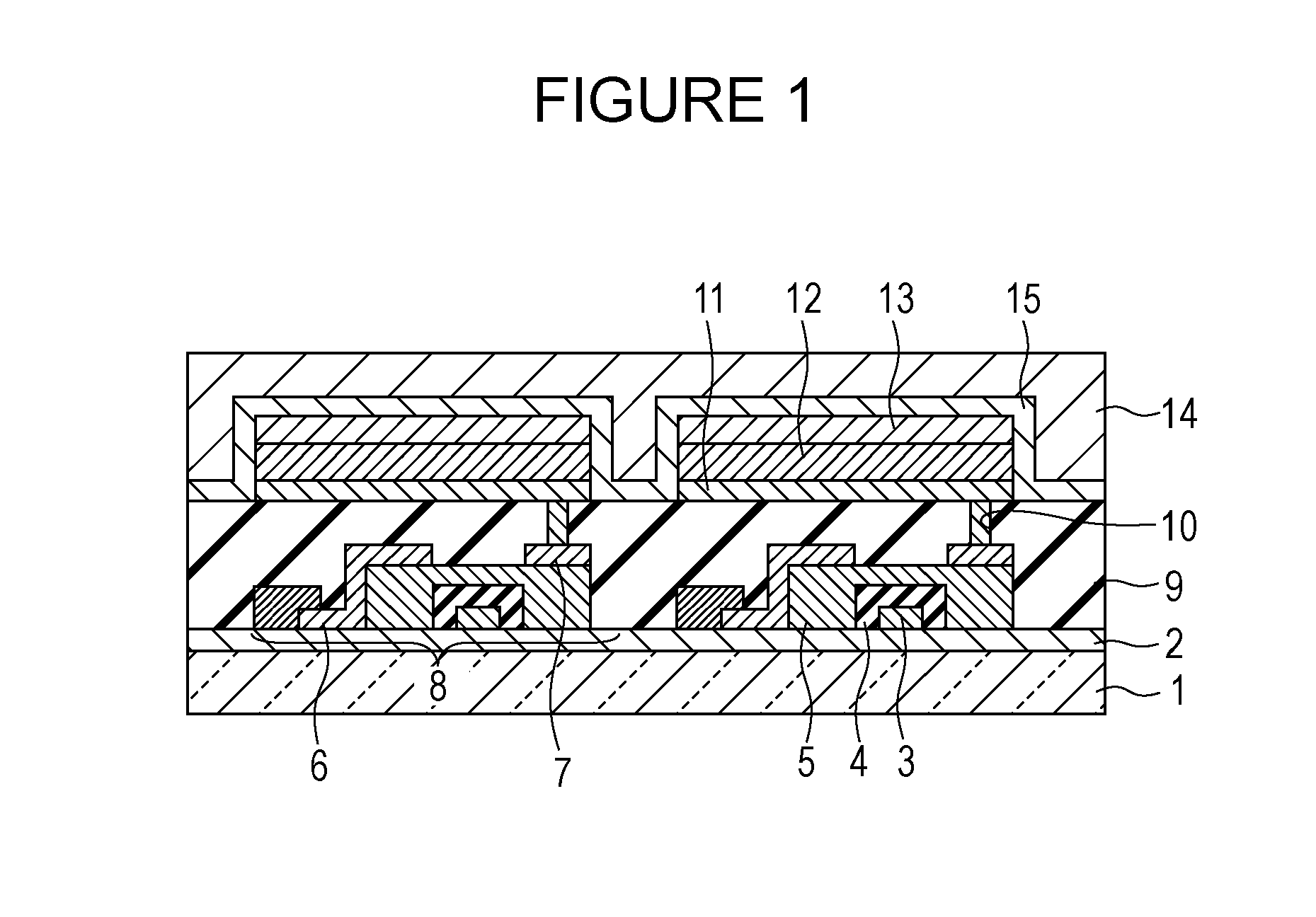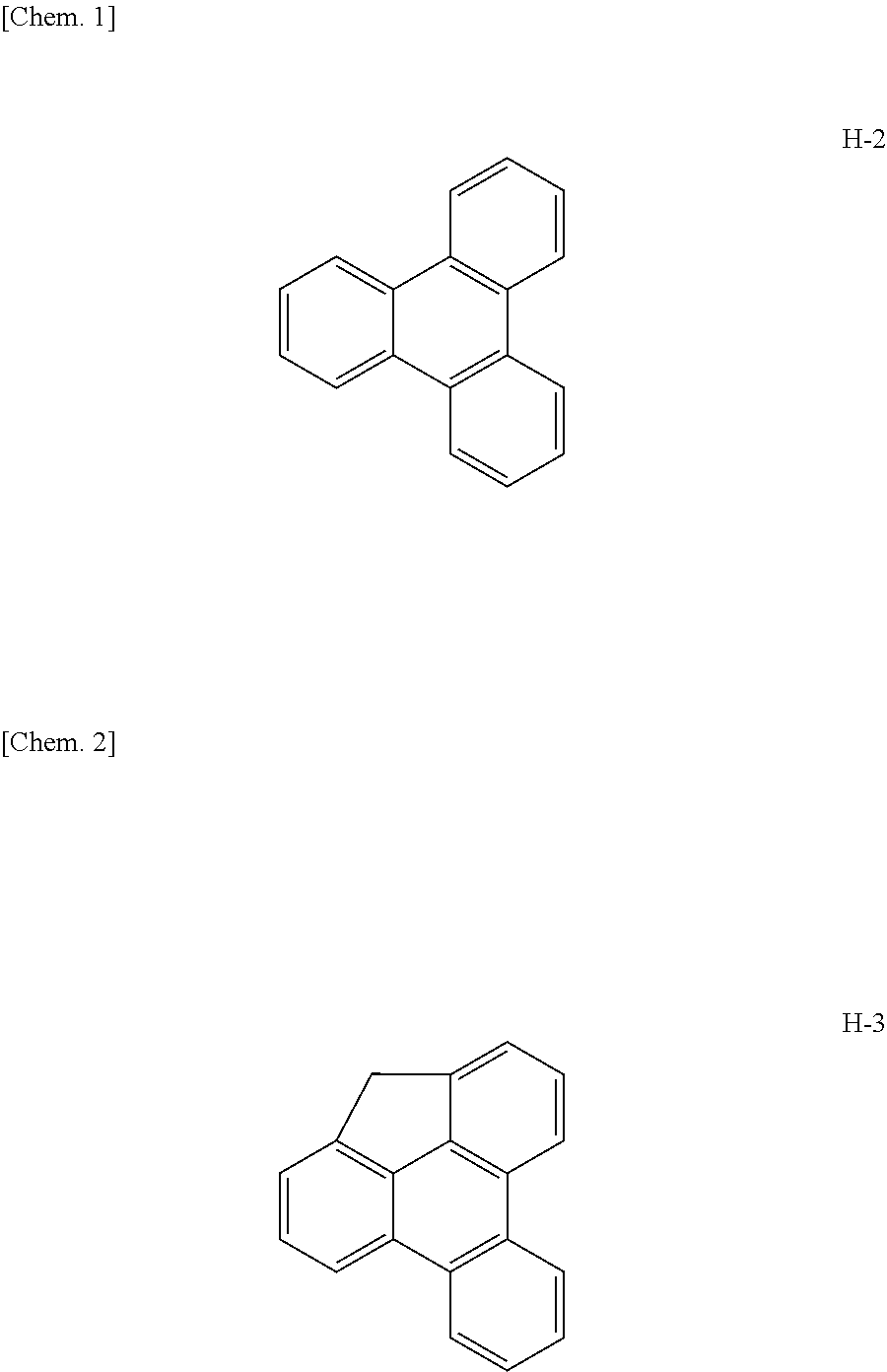New condensed polycyclic compound and organic light-emitting element using the same
a condensed polycyclic compound and organic light-emitting element technology, applied in the direction of organic chemistry, luminescent compositions, thermoelectric devices, etc., can solve the disadvantages of association between molecules, triphenylene and triphenylene as a mother skeleton, etc., and achieve low drive voltage and high light-emitting efficiency
- Summary
- Abstract
- Description
- Claims
- Application Information
AI Technical Summary
Benefits of technology
Problems solved by technology
Method used
Image
Examples
example compound
(Properties of Example Compound)
1) A Group
[0045]Measured values of T1 in dilute solutions of representative example compounds of an A group are shown in Table 3. The measurement of T1 was carried out in such a way that a toluene solution (1×10−4 mol / l) was cooled to 77K, a phosphorescence emission spectrum was measured at an excitation wavelength of 350 nm, and the primary emission peak was regarded as T1. As a measurement apparatus, a spectrophotometer U-3010 manufactured by Hitachi Ltd. was used.
TABLE 3EXAMPLE COMPOUND NO.Tl nm (MEASURED VALUE)A-1-2471A-1-8472A-2-2470A-2-4472A-2-6472A-2-8472A-3-1472
[0046]In the general formula [3], the compounds A-2-2, A-2-4, A-2-6, and A-2-8 each have hydrogen atoms as R1 and R2 and methyl groups as R3 and R4 and have different substituents as Ar. The T1 values of these compounds are all in a range of 470 to 472 nm and are almost equal to each other.
[0047]In the general formulas [2] to [4], the compounds A-1-8, A-2-6, and A-3-1 each have hydrogen...
example 1
Synthesis of Example Compound A-2-8
[0087]Synthesis was carried out in accordance with the following synthetic scheme.
Synthesis of Compound b-3
[0088]In a 300-ml three-neck flask, 7.0 g (26.0 mmol) of the compound b-1, 7.57 ml (52.0 mmol) of the compound b-2, 100 ml of toluene, and 20 ml of triethylamine were charged, and 1.4 g of [1,1′-bis(diphenylphosphino)propane]dichloro nickel was added at room temperature in a nitrogen atmosphere under stirring condition. The temperature was increased to 80° C., and stirring was performed for 8 hours. After the reaction, an organic layer was extracted with toluene, was then dried using anhydrous sodium sulfate, and was subsequently refined using a silica gel column (mixture of toluene and heptane: developing solvent), so that 7.45 g of the compound b-3 (white oil) (yield: 90.3%) was obtained.
Synthesis of Compound b-5
[0089]In a 300-ml three-neck flask, 9.69 g (35.9 mmol) of the compound b-3, 17.0 g (53.6 mmol) of the compound b-4, 32.5 g (100 mmo...
example 2
Synthesis of Example Compound A-1-2
[0097]The example compound A-1-2 was synthesized in a manner similar to that of Example 1 except that the compound b-7 was changed to the following compound c-1.
[0098]By mass spectrometry, 572, which was M+ of the example compound A-1-2, was confirmed. In addition, T1 of the example compound A-1-2 in a toluene dilute solution measured in a manner similar to that of Example 1 was 471 nm.
PUM
| Property | Measurement | Unit |
|---|---|---|
| excitation wavelength | aaaaa | aaaaa |
| ionization potential | aaaaa | aaaaa |
| thickness | aaaaa | aaaaa |
Abstract
Description
Claims
Application Information
 Login to View More
Login to View More - R&D
- Intellectual Property
- Life Sciences
- Materials
- Tech Scout
- Unparalleled Data Quality
- Higher Quality Content
- 60% Fewer Hallucinations
Browse by: Latest US Patents, China's latest patents, Technical Efficacy Thesaurus, Application Domain, Technology Topic, Popular Technical Reports.
© 2025 PatSnap. All rights reserved.Legal|Privacy policy|Modern Slavery Act Transparency Statement|Sitemap|About US| Contact US: help@patsnap.com



